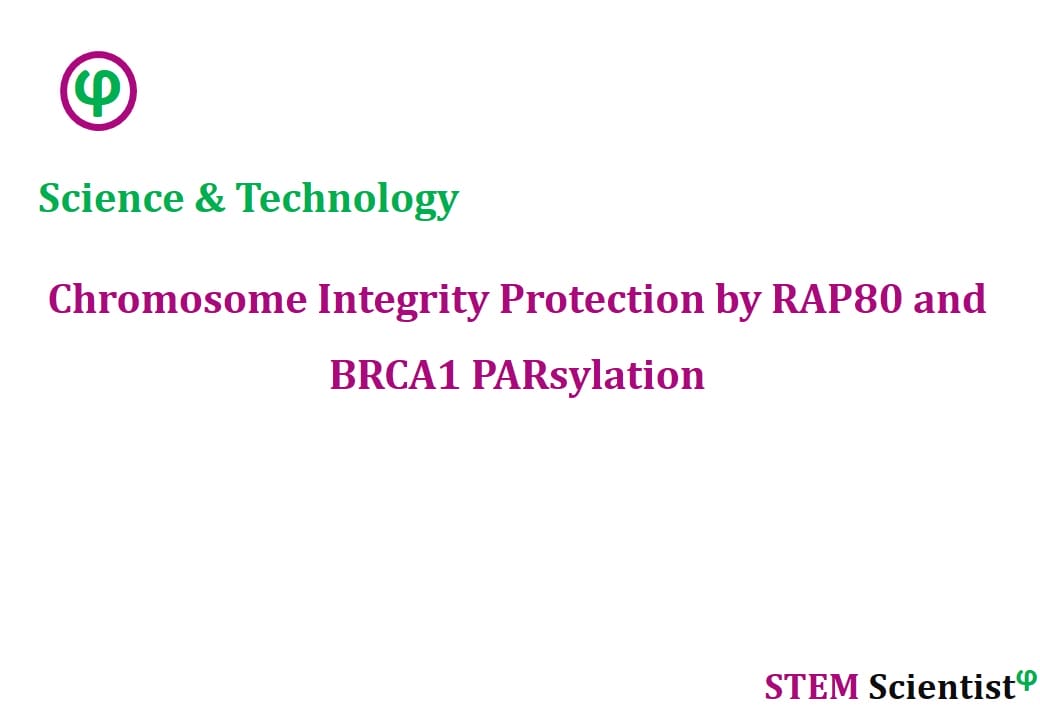
The following study was conducted by Scientists from Dana-Farber Cancer Institute, Boston; Harvard Medical School, Boston; Yale School of Medicine, Yale University, New Haven USA. Study is published in Proceedings of the National Academy of Sciences Journal as detailed below.
Proceedings of the National Academy of Sciences (2020); 117(4): 2084-2091
RAP80 and BRCA1 PARsylation Protect Chromosome Integrity by Preventing Retention of BRCA1-B/C Complexes in DNA Repair Foci
Significance
Normally, BRCA1 promotes physiological, error-free homologous recombination repair (HRR) of damaged DNA and genome stability. In contrast, excessive, deregulated HRR can lead to genome instability. The BRCA1-binding protein RAP80 restricts HRR amplitude and genome instability, at least in part by manifesting polyubiquitin and poly-ADP-ribose binding activities in postdamage nuclear foci. Although how these processes operate in detail remains unknown, we find that simultaneous defects in RAP80/BRCA1 complex formation and in BRCA1 poly-ADP-ribosylation result in the persistent accumulation of BRCA1-containing complexes in nuclear foci that also contain CtIP and BACH1. These effects lead to excessive HRR, chromosomal hyper-recombination, and gross chromosomal abnormalities.
Abstract
BRCA1 promotes error-free, homologous recombination-mediated repair (HRR) of DNA double-stranded breaks (DSBs). When excessive and uncontrolled, BRCA1 HRR activity promotes illegitimate recombination and genome disorder. We and others have observed that the BRCA1-associated protein RAP80 recruits BRCA1 to postdamage nuclear foci, and these chromatin structures then restrict the amplitude of BRCA1-driven HRR. What remains unclear is how this process is regulated. Here we report that both BRCA1 poly-ADP ribosylation (PARsylation) and the presence of BRCA1-bound RAP80 are critical for the normal interaction of BRCA1 with some of its partners (e.g., CtIP and BACH1) that are also known components of the aforementioned focal structures. Surprisingly, the simultaneous loss of RAP80 and failure therein of BRCA1 PARsylation results in the dysregulated accumulation in these foci of BRCA1 complexes. This in turn is associated with the intracellular development of a state of hyper-recombination and gross chromosomal disorder. Thus, physiological RAP80-BRCA1 complex formation and BRCA1 PARsylation contribute to the kinetics by which BRCA1 HRR-sustaining complexes normally concentrate in nuclear foci. These events likely contribute to aneuploidy suppression.
Source:
Proceedings of the National Academy of Sciences
URL: https://www.pnas.org/content/117/4/2084
Citation:
Vohhodina, J., K. J. Toomire, et al. (2020). “RAP80 and BRCA1 PARsylation protect chromosome integrity by preventing retention of BRCA1-B/C complexes in DNA repair foci.” Proceedings of the National Academy of Sciences 117(4): 2084-2091.


